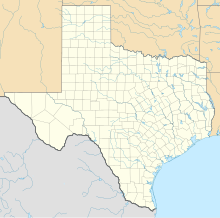Big Spring McMahon–Wrinkle Airport
Big Spring McMahon–Wrinkle Airport | |||||||||||||||
|---|---|---|---|---|---|---|---|---|---|---|---|---|---|---|---|
 | |||||||||||||||
 USGS image, 15 February 1997 | |||||||||||||||
| Summary | |||||||||||||||
| Airport type | Public | ||||||||||||||
| Owner/Operator | City of Big Spring | ||||||||||||||
| Serves | Big Spring, Texas | ||||||||||||||
| Elevation AMSL | 2,573 ft / 784 m | ||||||||||||||
| Coordinates | 32°12′45″N 101°31′18″W / 32.21250°N 101.52167°WCoordinates: 32°12′45″N 101°31′18″W / 32.21250°N 101.52167°W | ||||||||||||||
| Website | www.mybigspring.com/... | ||||||||||||||
| Map | |||||||||||||||
 BPG | |||||||||||||||
| Runways | |||||||||||||||
| |||||||||||||||
| Statistics (2009) | |||||||||||||||
| |||||||||||||||
Big Spring McMahon–Wrinkle Airport[2] (IATA: HCA, ICAO: KBPG, FAA LID: BPG) is a municipal airport two miles southwest of Big Spring, in Howard County, Texas.[3] The FAA's National Plan of Integrated Airport Systems for 2009–2013 categorized it as a general aviation airport.[4]
Most U.S. airports use the same three-letter location identifier for the FAA and IATA, but this airport is BPG to the FAA and HCA to the IATA[1] (which assigned BPG to Barra do Garças Airport in Barra do Garças, Mato Grosso, Brazil[5]).
History[]
World War II[]
Big Spring Army Air Field opened on 28 April 1942 as part of the United States Army Air Forces Central Flying Training Command; it was to train aviation cadets in high altitude precision bombing.[AFHRA 1] The airfield received its first class of cadets in September 1942. The AT-11 (Beechcraft Model 18) and the B-18 Bolo were the primary aircraft flown for training. The 79th Bombardier Training Group[AFHRA 2] continued operations until the surrender of Japan, when the cadets who agreed to remain in postwar service were transferred to Midland AAF, Texas. The last class graduated on 26 September 1945. The base was declared surplus and reverted to city control in November 1945,[AFHRA 3] and it was Big Spring Municipal Airport for six years.
Pioneer Airlines arrived in 1947; successor Continental moved to the new Howard County Airport northeast of Big Spring in 1960–61. Trans-Texas replaced Continental at HCA in 1963; it pulled out in 1974, and HCA closed by 1985.
Webb Air Force Base[]
As a result of the need for trained pilots for the Korean War, the airfield reopened on October 1, 1951. The base was renamed Webb Air Force Base in 1952 for Lieutenant James L. Webb, a Big Spring native and World War II combat pilot, who was killed off the Japanese coast in 1949.
The 3560th Pilot Training Wing (later redesignated the 78th Flying Training Wing) was stationed at the base, and instruction of the first class began in April 1952. The base population soon passed the 2,000 mark. By the end of 1968 almost 9,000 pilots had been trained at Webb.
In 1956 the 331st Fighter Interceptor Squadron was transferred to Webb from Stewart Air Force Base in New York to defend the southern United States border on air intercept missions. In March 1967 the 331st was redesignated the 4760th Combat Crew Training Squadron and charged with training Royal Jordanian Air Force students. It was inactivated when the Jordanians were recalled because of the war with Israel in the summer of 1967.
Webb was also the site of annual summer training for college Air Force Reserve Officers Training Corps (AFROTC) cadets throughout the 1950s and most of the 1960s. In 1977 the end of the Vietnam War meant a decrease in the need for Air Force pilots. Webb was formally deactivated, and the property it had occupied was turned over to the Big Spring Industrial Park.
Facilities[]
The airport covers 2,086 acres (844 ha) and has two paved runways: 17/35 is 8,802 x 100 ft (2,683 x 30 m) and 6/24 is 4,601 x 75 ft (1,402 x 23 m).[3]
The airport is uncontrolled, limited to UNICOM advisories only. The former Webb AFB control tower still stands, but it has not been operational since the Air Force's departure in late 1977 and the airfield's conversion to a civil airport.
In the year ending January 30, 2009 the airport had 12,195 aircraft operations, average 33 per day: 91% general aviation and 9% military. 48 aircraft were then based at this airport: 73% single-engine, 13% multi-engine, 6% jet, 6% ultralight and 2% helicopter.[3]
Other tenants[]
Three units of the Big Spring Correctional Center (a federal prison privately operated by Cornell Companies) are located on the base grounds (as well as FCI Big Spring, a separate facility operated directly by the Bureau of Prisons).
See also[]
References[]
- ^ a b "Airline and Airport Code Search". IATA. Retrieved 12 November 2015.
- ^ a b "Big Spring McMahon–Wrinkle Airport". City of Big Spring. Archived from the original on 2 August 2010. Retrieved 24 May 2010.
- ^ a b c d FAA Airport Form 5010 for BPG PDF. Federal Aviation Administration. Effective 11 February 2010.
- ^ National Plan of Integrated Airport Systems for 2009–2013: Appendix A: Part 5 (PDF, 1.18 MB) Archived 2011-06-06 at the Wayback Machine. Federal Aviation Administration. Updated 15 October 2008.
- ^ "Barra do Garças, Mato Grosso, Brazil (IATA: BPG, ICAO: SBBW)". Great Circle Mapper. Retrieved 24 May 2010.
AFHRA[]
![]() This article incorporates public domain material from the Air Force Historical Research Agency website http://www.afhra.af.mil/.
This article incorporates public domain material from the Air Force Historical Research Agency website http://www.afhra.af.mil/.
External links[]
- Former Webb AFB and Hangar 25 Air Museum website (Includes expanded history of the AFB)
- FAA Terminal Procedures for BPG, effective December 2, 2021
- Resources for this airport:
- FAA airport information for BPG
- AirNav airport information for KBPG
- FlightAware airport information and live flight tracker
- NOAA/NWS weather observations: current, past three days
- SkyVector aeronautical chart, Terminal Procedures
- Airports in Texas
- Buildings and structures in Howard County, Texas
- Transportation in Howard County, Texas
